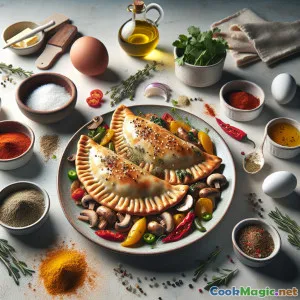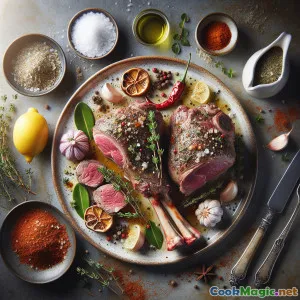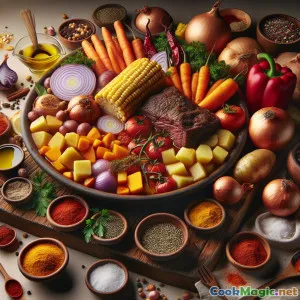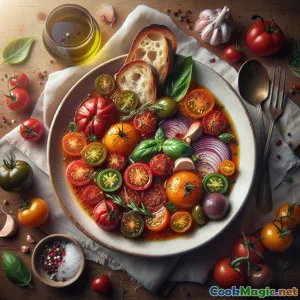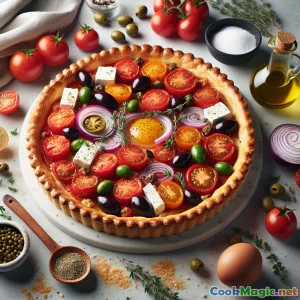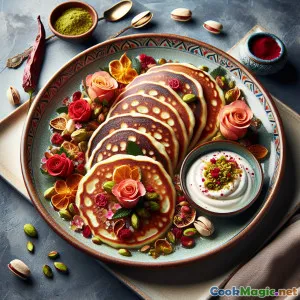
Yerba-Mate-Eis mit Zitrusfrüchten
(Yerba Mate Citrus Ice Cream)
(0 Bewertungen)0
176
Oktober 19, 2025
Problem melden
Zutaten
-
500 ml Vollmilch
(Use full-fat for best texture)
-
400 ml Schlagsahne (35% Fett)
(Chilled; higher fat gives a silkier scoop)
-
150 grams Kristallzucker
(Reduce to 120 g for a less sweet finish)
-
5 pieces Eigelb
(Room temperature; enriches body and emulsifies)
-
20 grams Lose yerba-mate-blätter
(Choose your preferred blend; unsmoked gives gentler flavor)
-
2 tsp Orangenschale, fein gerieben
(Avoid white pith to prevent bitterness)
-
1 tsp Zitronenschale, fein gerieben
(Adds brightness to the herbal notes)
-
0.5 tsp Limettenschale (fein gerieben)
(Aromatic edge; optional but recommended)
-
80 ml Frisch gepresster Orangensaft
(Add after cooling to avoid curdling)
-
30 ml Frischer Zitronensaft
(Balances sweetness; add after cooling)
-
0.25 tsp feines Meersalz
(Enhances flavor and rounds bitterness)
-
1 tsp Vanilleextrakt
(Optional but smooths the herbal profile)
-
30 grams Glukose oder heller Maissirup
(Reduces iciness and keeps scoops soft)
-
10 ml Neutraler Spirit (Wodka oder Cachaça)
(Prevents hard freeze; flavor-neutral)
-
120 grams Zitrus-Supremen (Orange oder Grapefruit), gehackt
(For rippling or topping; well-drained)
(Use full-fat for best texture)
(Chilled; higher fat gives a silkier scoop)
(Reduce to 120 g for a less sweet finish)
(Room temperature; enriches body and emulsifies)
(Choose your preferred blend; unsmoked gives gentler flavor)
(Avoid white pith to prevent bitterness)
(Adds brightness to the herbal notes)
(Aromatic edge; optional but recommended)
(Add after cooling to avoid curdling)
(Balances sweetness; add after cooling)
(Enhances flavor and rounds bitterness)
(Optional but smooths the herbal profile)
(Reduces iciness and keeps scoops soft)
(Prevents hard freeze; flavor-neutral)
(For rippling or topping; well-drained)
Nährwerte
- Portionen: 6
- Portionsgröße: 2 scoops (150 g)
- Calories: 430 kcal
- Carbohydrates: 0 g
- Protein: 5.5 g
- Fat: 31 g
- Fiber: 0.5 g
- Sugar: 30 g
- Sodium: 90 mg
- Cholesterol: 190 mg
- Calcium: 170 mg
- Iron: 0.8 mg
Anweisungen
-
1 - Warm dairy and zest:
In a medium pot, combine milk, cream, half the sugar (75 g), glucose if using, orange zest, lemon zest, and lime zest. Heat over medium until steaming and small bubbles form at edges (about 75–80°C), stirring to dissolve sugar.
-
2 - Infuse with yerba mate:
Remove from heat. Stir in the yerba mate. Cover and steep 8–10 minutes, tasting at 7 minutes. The base should be aromatic, lightly tannic, and pleasantly herbal.
-
3 - Strain the infusion:
Strain through a fine-mesh sieve lined with cheesecloth into a clean pot, pressing gently on the leaves to extract flavor without forcing fine particles through. Discard solids.
-
4 - Whisk yolks and sugar:
In a bowl, whisk egg yolks with remaining 75 g sugar and salt until slightly pale and thickened, about 60–90 seconds.
-
5 - Temper and cook custard:
Gradually ladle hot yerba mate dairy into yolks while whisking. Return mixture to pot. Cook over medium-low, stirring constantly with a silicone spatula, until it coats the back of a spoon (82–84°C). Do not boil.
-
6 - Finish and cool base:
Remove from heat. Stir in vanilla if using. Set the pot in an ice bath and stir until cooled to below 30°C. Whisk in orange and lemon juices and the neutral spirit if using.
-
7 - Mature the base:
Cover and refrigerate 4–12 hours. This rest hydrates proteins, settles tannins, and improves body and scoopability.
-
8 - Churn to soft serve:
Churn the chilled base in an ice cream maker per manufacturer’s instructions until thick and softly aerated, 20–25 minutes.
-
9 - Ripple and harden:
Layer churned ice cream into a cold container, alternating with chopped citrus supremes if using. Swirl gently. Press parchment onto the surface, cover, and freeze 2–4 hours until scoopable.
-
10 - Serve:
Scoop into chilled bowls. Garnish with extra zest or a few citrus segments. Let sit 2 minutes at room temperature for optimal texture.
In a medium pot, combine milk, cream, half the sugar (75 g), glucose if using, orange zest, lemon zest, and lime zest. Heat over medium until steaming and small bubbles form at edges (about 75–80°C), stirring to dissolve sugar.
Remove from heat. Stir in the yerba mate. Cover and steep 8–10 minutes, tasting at 7 minutes. The base should be aromatic, lightly tannic, and pleasantly herbal.
Strain through a fine-mesh sieve lined with cheesecloth into a clean pot, pressing gently on the leaves to extract flavor without forcing fine particles through. Discard solids.
In a bowl, whisk egg yolks with remaining 75 g sugar and salt until slightly pale and thickened, about 60–90 seconds.
Gradually ladle hot yerba mate dairy into yolks while whisking. Return mixture to pot. Cook over medium-low, stirring constantly with a silicone spatula, until it coats the back of a spoon (82–84°C). Do not boil.
Remove from heat. Stir in vanilla if using. Set the pot in an ice bath and stir until cooled to below 30°C. Whisk in orange and lemon juices and the neutral spirit if using.
Cover and refrigerate 4–12 hours. This rest hydrates proteins, settles tannins, and improves body and scoopability.
Churn the chilled base in an ice cream maker per manufacturer’s instructions until thick and softly aerated, 20–25 minutes.
Layer churned ice cream into a cold container, alternating with chopped citrus supremes if using. Swirl gently. Press parchment onto the surface, cover, and freeze 2–4 hours until scoopable.
Scoop into chilled bowls. Garnish with extra zest or a few citrus segments. Let sit 2 minutes at room temperature for optimal texture.
Mehr über: Yerba-Mate-Eis mit Zitrusfrüchten
Overview
Helado de Yerba Mate y Frutas Cítricas marries Argentina’s beloved herbal infusion with a bright, zesty citrus profile in a silky custard ice cream. Imagine the soothing, gently grassy aroma of yerba mate carried on a cloud of cream, lifted by the sparkle of orange and lemon. The result is refreshing yet indulgent—an elegant after-dinner scoop in summer, and a conversation-starting finale at any Latin American–inspired gathering.
Why this recipe works
- Balanced flavor architecture: Yerba mate can read as grassy, woody, or tannic depending on brand and brew time. By infusing the dairy (rather than water) and keeping the steep brief, its bitterness is tamed while its eucalyptus-like aromatics bloom. Zests infuse alongside, providing citrus oils without watering down the base.
- Custard technique for body: Egg yolks emulsify fat and water, lending luscious texture and a stable scoop. Cooking to 82–84°C ensures the custard coats the spoon without scrambling.
- Acid added cold: Citrus juice is stirred in after cooling. This preserves bright top notes and prevents curdling. A small splash of neutral spirit is optional insurance against ice crystals.
- Optional glucose: A touch of glucose or corn syrup binds free water, reduces iciness, and keeps the ice cream supple straight from the freezer.
Ingredient notes
- Yerba mate: Argentine styles range from suaves (gentle) to intensos (robust). Unsmoked blends bring a cleaner profile ideal for dessert. If you enjoy deeper, earthy notes, try a smoked mate, but shorten the steep to avoid overpowering bitterness.
- Citrus: Orange forms the sweet backbone; lemon sharpens the edges; lime is optional for a neon-green aromatic wink. Use fresh zest only—avoid the white pith, which is bitter.
- Dairy: Full-fat milk and heavy cream are non-negotiable for a creamy mouthfeel. Lower fat bases magnify tannins.
- Sweeteners: Sugar levels are calibrated to balance acid and bitterness. Reducing sugar will firm the texture and amplify tannins; add 5–10 g glucose if dialing sugar down.
Technique tips
- Steeping discipline: Taste the infusion starting at minute 7. Different mate brands extract at different rates. Stop once it’s fragrant and lightly tannic; remember the custard will concentrate slightly on cooking.
- Straining matters: A double layer of cheesecloth prevents fine leaf dust from sneaking into the base, which can make the texture sandy over time.
- Temperature control: Stir constantly when cooking the custard and use a thermometer. If you overshoot and see steam bursts, immediately remove from heat and whisk vigorously.
- Rapid chill: An ice bath not only improves safety—it locks in volatile citrus aromas and minimizes graininess.
- Maturation: The overnight rest is like magic. Proteins relax, air incorporates more evenly during churn, and the mate’s edges round out.
No-churn option
- Whip 400 ml cold heavy cream to soft peaks with half the sugar. In a separate bowl, combine sweetened condensed milk (300 g) with the cooled, double-strength mate–zest infusion (reduced to 150 ml) and citrus juices. Fold together gently, add optional spirit, and freeze 6–8 hours. Texture won’t be identical to custard-churned, but the herbal-citrus profile shines.
Cultural context and serving ideas
Yerba mate is an everyday ritual across Argentina, Uruguay, Paraguay, and southern Brazil—shared from a gourd with a bombilla among friends. Translating that social, restorative beverage into dessert honors the culture while presenting it in a fresh form that resonates globally. Serve this helado between courses as a palate cleanser, or pair with alfajores for a playful, Argentina-on-a-plate moment. A drizzle of honey, a few candied orange peels, or shards of dark chocolate provide delightful textural contrast.
Variations
- Grapefruit twist: Swap half the orange juice for pink grapefruit; add a pinch of grapefruit zest for perfume.
- Dulce de leche ripple: After churning, fold in thin ribbons of gently warmed dulce de leche for a rich Argentinian accent.
- Herbal duet: Add 2–3 crushed green cardamom pods to the initial dairy warm-up, removing before tempering.
- Vegan route: Use 700 ml full-fat coconut milk and 80 g sugar, 40 g glucose, plus 10 g cornstarch. Omit yolks; simmer to thicken lightly before infusing mate. Expect a coconut backdrop.
Make-ahead and storage
- Best within 1–2 weeks for peak aroma; citrus top notes fade over long storage.
- Press parchment directly on the surface to prevent ice crystals and flavor absorption from the freezer.
- If too firm, temper at room temperature for 3–5 minutes before scooping.
Troubleshooting
- Too bitter: Shorten mate steep by 2–3 minutes next time, or increase sugar by 10–15 g. A pinch more salt can also round edges.
- Icy texture: Ensure the base cooled completely before churning, increase glucose by 10 g, or add the optional spirit.
- Curdled base: If acid was added when hot, strain and blend smooth with an immersion blender, chill thoroughly, and churn. Flavor remains good, though body may be lighter.
This helado captures the soul of mate—shared, soothing, and vibrant—while citrus keeps every spoonful bright. It’s a dessert that feels simultaneously novel and comfortingly familiar, bridging daily ritual and celebration.






